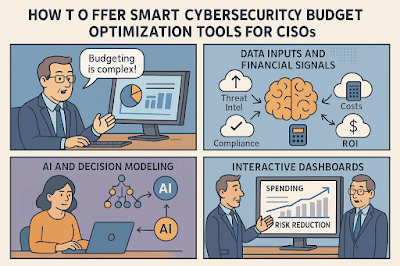How to Offer Smart Cybersecurity Budget Optimization Tools for CISOs
Chief Information Security Officers (CISOs) are increasingly tasked with protecting enterprise assets against a growing range of cyber threats—while simultaneously reducing costs and justifying spend to the board.
Yet many cybersecurity budgets are still allocated based on legacy models or intuition rather than data-driven prioritization.
Smart budget optimization tools help CISOs model ROI, simulate breach scenarios, and allocate funds based on business impact, threat intelligence, and compliance risks.
This post outlines how to build and deliver these tools for cybersecurity leaders in large and mid-sized enterprises.
Table of Contents
- Why Budget Optimization Tools Are Critical
- Data Inputs and Financial Signals
- AI and Decision Modeling Approaches
- User Interface and Executive Reporting
- Top Tools and Go-to-Market Strategy
💰 Why Budget Optimization Tools Are Critical
CISOs must defend their budgets annually, often facing these challenges:
- Spending spread across disconnected vendors
- No clear visibility on which investments reduce the most risk
- Difficulty mapping budget to outcomes or risk appetite
Optimization engines bring transparency to budget decisions and align spending with strategic security goals.
📊 Data Inputs and Financial Signals
- Threat intelligence feeds and industry risk benchmarks
- Historical incident response costs and breach analytics
- Security maturity assessment (e.g., NIST CSF score)
- Existing tech stack cost and redundancy analysis
🧠 AI and Decision Modeling Approaches
- Optimization algorithms (e.g., linear programming, Bayesian modeling)
- Scenario simulations for ransomware, insider threat, and cloud breaches
- ML-powered risk scoring per asset, application, or business unit
- ROI calculations based on time-to-detect, prevent, or recover
Include sensitivity analysis features to reflect budget constraints or regulatory mandates.
📈 User Interface and Executive Reporting
- Interactive dashboards showing spend vs. risk reduction
- “What-if” sliders for adjusting investment levels across domains
- Executive summaries for board communication
- Regulatory compliance mapping (e.g., GDPR, HIPAA, CMMC)
🛠️ Top Tools and Go-to-Market Strategy
- SafeBreach: Breach simulation with budget prioritization
- Cynet: Security consolidation and cost efficiency scoring
- CSF Tools: Cyber budgeting aligned with NIST framework
- Resilience: Budget optimization via insurance-backed cyber modeling
🔗 Related Cybersecurity & Enterprise Risk Posts
Keywords: CISO budgeting tools, cybersecurity ROI, AI budget optimization, cyber risk allocation, security spend efficiency

